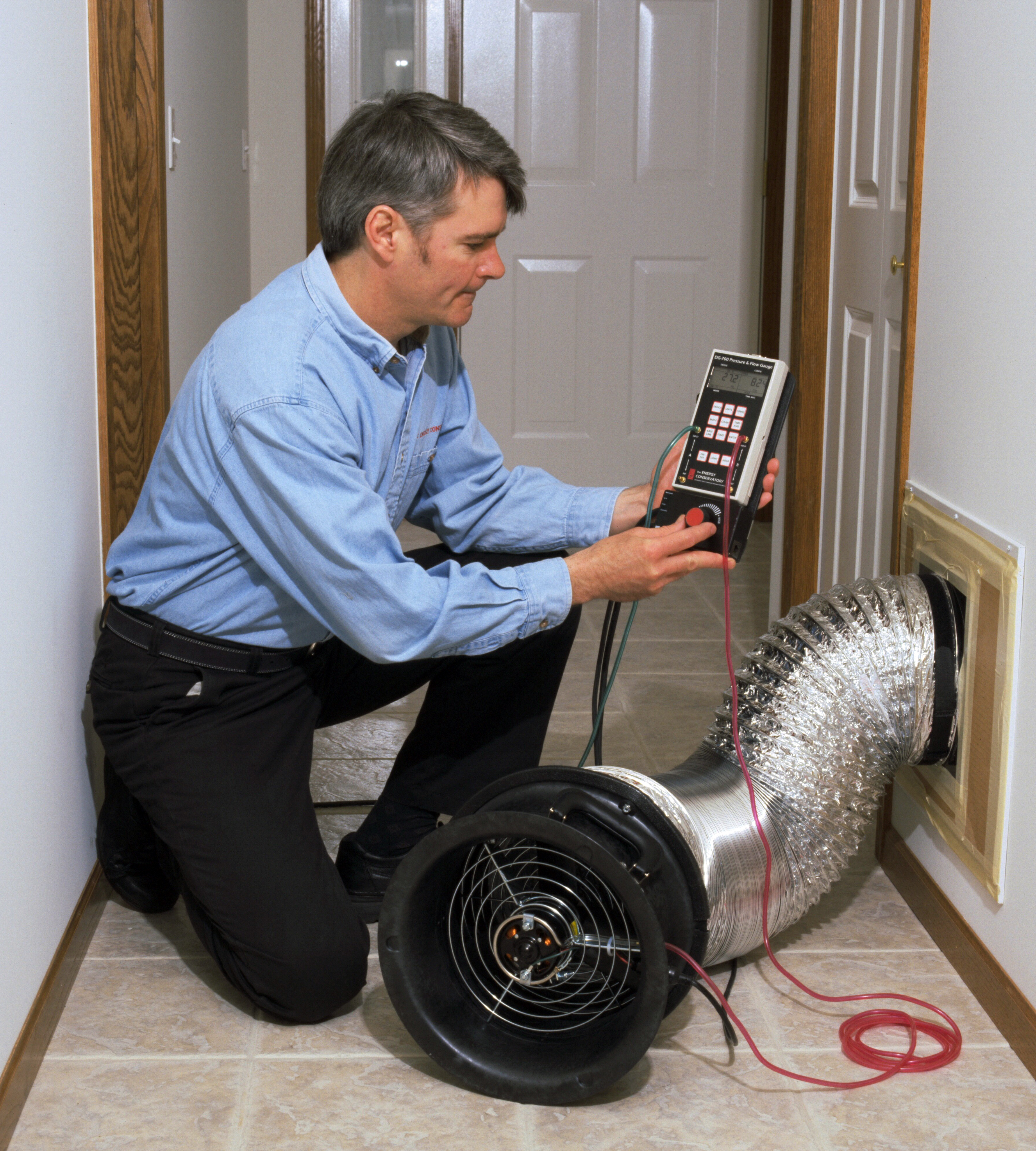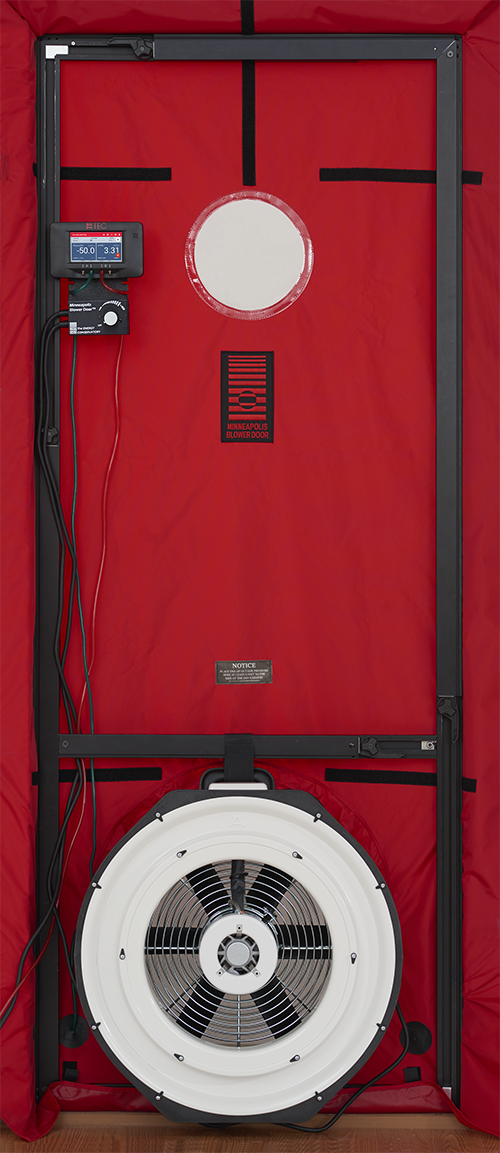|
Duct Leakage Testing
A duct leakage tester is a diagnostic tool designed to measure the airtightness of forced air heating, ventilating and air-conditioning (HVAC) ductwork. A duct leakage tester consists of a calibrated fan for measuring an air flow rate and a pressure sensing device to measure the pressure created by the fan flow. The combination of pressure and fan flow measurements are used to determine the ductwork airtightness. The airtightness of ductwork is useful knowledge when trying to improve energy conservation. Uses Duct leakage testers are used in residential single family, residential multi-family, and commercial buildings that have a forced air delivery systems for heating and cooling. Operation A basic duct leakage testing system includes three components: a calibrated fan, a register sealing system, and a device to measure fan flow and building pressure. Supply registers or return air grills are sealed using adhesive tapes, cardboard, or non-adhesive reusable seals. One register o ... [...More Info...] [...Related Items...] OR: [Wikipedia] [Google] [Baidu] |
Duct Blaster
The word duct is derived from the Latin word for ''led/leading''. It may refer to: * Duct (anatomy), various ducts in anatomy and physiology ** Tear duct, which carry tears to the eyes * Duct (HVAC), for transfer of air between spaces in a structure * Duct tape, a kind of adhesive tape * Ducted fan, motor for aircraft * Electrical bus duct, a metal enclosure for busbars * Duct (industrial exhaust), industrial exhaust duct system designed for low pressure-pneumatic convey of gas, fumes, dusts, shavings, and other pollutants from works space to atmosphere after cleaning and removal of contaminants * Atmospheric duct, a horizontal layer in the lower atmosphere in which the vertical refractive index gradients are such that radio signals (a) are guided or ducted, (b) tend to follow the curvature of the Earth, and (c) experience less attenuation in the ducts than they would if the ducts were not present ** Tropospheric ducting, a type of radio propagation in the troposphere that allow ... [...More Info...] [...Related Items...] OR: [Wikipedia] [Google] [Baidu] |
Energy Conservation
Energy conservation is the effort to reduce wasteful energy consumption by using fewer energy services. This can be done by using energy more effectively (using less energy for continuous service) or changing one's behavior to use less service (for example, by driving less). Energy conservation can be achieved through energy efficiency, which has a number of advantages, including a reduction in greenhouse gas emissions, a smaller carbon footprint, and cost, water, and energy savings. Energy conservation is an essential factor in building design and construction. It has increased in importance since the 1970s, as 40% of energy use in the U.S. is in buildings. Recently, concern over the effects of climate change and global warming has emphasized the importance of energy conservation. Energy can only be transformed from one form to another, such as when heat energy is converted into vehicle motive power or when water flow's kinetic energy is converted into electricity in hydroelectr ... [...More Info...] [...Related Items...] OR: [Wikipedia] [Google] [Baidu] |
Sheet Metal And Air Conditioning Contractors' National Association
The Sheet Metal and Air Conditioning Contractors' National Association (SMACNA; pronounced 'Smack'-'Nah') is an international trade association with more than 4,500 contributing contractor members in 103 chapters throughout the United States, Canada, Australia and Brazil. Its headquarters is in Chantilly, Virginia. Member profile SMACNA members perform work in industrial, commercial, institutional and residential markets. They specialize in heating, ventilation and air conditioning ( HVAC); architectural sheet metal; industrial sheet metal; kitchen equipment; specialty stainless steel work; manufacturing; siding and decking; testing and balancing; service; and energy management and maintenance. Technical manuals and standards The voluntary technical standards and manuals developed by SMACNA Contractors have found worldwide acceptance by the construction and design community, as well as local, national, and foreign government agencies. ANSI, the American National Standards Inst ... [...More Info...] [...Related Items...] OR: [Wikipedia] [Google] [Baidu] |
Thermal Envelope
A building envelope is the physical separator between the conditioned and unconditioned environment of a building including the resistance to air, water, heat, light, and noiseSyed, Asif. ''Advanced building technologies for sustainability''. Hoboken, N.J.: John Wiley & Sons, Inc., 2012. 115. Print. transfer. Discussion The building envelope (or the more modern term, building enclosure) is all of the elements of the outer shell that maintain a dry, heated, or cooled indoor environment and facilitate its climate control. Building envelope design is a specialized area of architectural and engineering practice that draws from all areas of building science and indoor climate control. The many functions of the building envelope can be separated into three categories:Straube, J.F., Burnett, E.F.P. ''Building Science for Building Enclosures''. Building Science Press, Westford, 2005. * Support (to resist and transfer structural and dynamic loads) * Control (the flow of matter and energy of ... [...More Info...] [...Related Items...] OR: [Wikipedia] [Google] [Baidu] |
Blower Door
A blower door is a machine used to measure the airtightness of buildings. It can also be used to measure airflow between building zones, to test ductwork airtightness and to help physically locate air leakage sites in the building envelope. There are three primary components to a blower door: (1) a calibrated, variable-speed blower or fan, capable of inducing a range of airflows sufficient to pressurize and depressurize a variety of building sizes, (2) a pressure measurement instrument, called a manometer, to simultaneously measure the pressure differential induced across the face of the fan and across the building envelope, as a result of fan airflow, and (3) a mounting system, used to mount the fan in a building opening, such as a door or a window. Air tightness testing is usually thought of in residential settings. It is becoming more common in commercial settings. The General Services Administration (GSA) requires testing of new US federal government buildings. A variety o ... [...More Info...] [...Related Items...] OR: [Wikipedia] [Google] [Baidu] |
Pressure Pan Application
Pressure (symbol: ''p'' or ''P'') is the force applied perpendicular to the surface of an object per unit area over which that force is distributed. Gauge pressure (also spelled ''gage'' pressure)The preferred spelling varies by country and even by industry. Further, both spellings are often used ''within'' a particular industry or country. Industries in British English-speaking countries typically use the "gauge" spelling. is the pressure relative to the ambient pressure. Various units are used to express pressure. Some of these derive from a unit of force divided by a unit of area; the SI unit of pressure, the pascal (Pa), for example, is one newton per square metre (N/m2); similarly, the pound-force per square inch (psi) is the traditional unit of pressure in the imperial and U.S. customary systems. Pressure may also be expressed in terms of standard atmospheric pressure; the atmosphere (atm) is equal to this pressure, and the torr is defined as of this. Manometric u ... [...More Info...] [...Related Items...] OR: [Wikipedia] [Google] [Baidu] |


